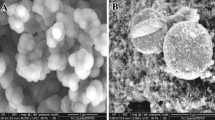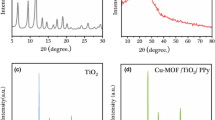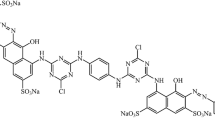Abstract
The interest is given on the preparation of nanocomposites of titanium dioxide (TiO2) with conducting polymer polypyrrole (PPy) because the resulting composites possess enhanced photocatalytic activity under visible light in comparison with pure TiO2 photocatalyst. In such composite, there is a synergistic activity of the components. It is very important to optimize the synthesis conditions in order to obtain PPy/TiO2 composites with the optimal thickness of conductive polymer layer on TiO2 and minimal possible aggregation of particles. PPy/TiO2 composites were characterized by Fourier transform infrared spectroscopy, X-ray powder diffraction, UV–Vis spectroscopy, scanning electron microscopy and transmission electron microscopy. The photocatalytic efficiency of the samples was determined by following the decomposition of Reactive Red 45 dye under UV and visible light, which was monitored by UV–Vis spectroscopy (as a change in absorbance of wavelength at 542 nm). The results show enhanced photocatalytic efficiency of the samples under visible light.













Similar content being viewed by others
References
Lang X, Chen X, Zhao J (2014) Heterogeneous visible light photocatalysis for selective organic transformations. Chem Soc Rev 43:473–486. https://doi.org/10.1039/c3cs60188a
Serpone N, Emeline AV (2012) Semiconductor photocatalysis—past, present, and future outlook. J Phys Chem Lett 3:673–677. https://doi.org/10.1021/jz300071j
Jing L, Zhou W, Tiana G, Fu H (2013) Surface tuning for oxide-based nanomaterials as efficient photocatalysts. Chem Soc Rev 42:9509–9549. https://doi.org/10.1039/C3CS60176E
Pelaez M et al (2012) A review on the visible light active titanium dioxide photocatalysts for environmental applications. Appl Catal B 125:331–349. https://doi.org/10.1016/j.apcatb.2012.05.036
Plass R, Pelet S, Krueger J, Gratzel M (2002) Quantum dot sensitization of organic–inorganic hybrid solar cells. J Phys Chem B 106:7578–7583. https://doi.org/10.1021/jp020453l
Park JH, Kim S, Bard A (2006) Novel carbon-doped TiO2 nanotube arrays with high aspect ratios for efficient solar water splitting. J Nano Lett 6:24–28. https://doi.org/10.1021/nl051807y
Umebayashi T, Yamaki T, Itoh H, Asai K (2002) Band gap narrowing of titanium dioxide by sulfur doping. Appl Phys Lett 81:454–456. https://doi.org/10.1063/1.1493647
Asahi R, Morikawa T, Ohwaki T, Aoki K, Taga Y (2001) Visible-light photocatalysis in nitrogen-doped titanium oxides. Science 293:269–271. https://doi.org/10.1126/science.1061051
Chen X, Liu L, Yu PY, Mao SS (2011) Increasing solar absorption for photocatalysis with black hydrogenated titanium dioxide nanocrystals. Science 331:746–750. https://doi.org/10.1126/science.1200448
Cobo I, Li M, Sumerlin BS, Sébastien Perrier S (2015) Smart hybrid materials by conjugation of responsive polymers to biomacromolecules. Nat Mater 14:143–159. https://doi.org/10.1038/nmat4106
Lutteroti L. Material analysis using diffraction (MAUD). General diffraction/reflectivity analysis program. http://www.ing.unitn.it/~maud/index.html. Accessed 1 June 2017
López R, Gómez R, Oros S (2011) Photophysical and photocatalytic properties of TiO2–Cr sol–gel prepared semiconductors. Catal Today 166:159–165. https://doi.org/10.1016/j.cattod.2011.01.010
Jeeju PP, Varma SJ, Puthampadath AFS, Sajimol AM, Jayalekshmi S (2012) Novel polypyrrole films with excellent crystallinity and good thermal stability Mater. Chem Phys 134:803–808. https://doi.org/10.1016/j.matchemphys.2012.03.072
Dai T, Yang X, Lu Y (2007) Conductive composites of polypyrrole and sulfonic-functionalized silica spheres. Mater Lett 61:3142–3145. https://doi.org/10.1016/j.matlet.2006.11.012
Pine SH, Hendrickson JB, Cram DJ, Hammond GS (1980) Organic chemistry, 4th edn. McGraw-Hill Kogakusha LTD, Tokyo
Turcu RP, Bica D, Vekas L, Aldea N, Macovei D, Nan A, Pana O, Marinica O, Grecu R, Pop CVL (2006) Synthesis and characterization of nanostructured polypyrrole-magnetic particles hybrid material. Romanian Rep Phys 58:359–367
Klug HP, Alexander LE (1974) X-ray diffraction procedures for polycrystalline and amorphous materials, 2nd edn. Wiley, New York
Metin A, Cilgi GK, Kuru FD, Cetisli H (2013) Thermal decomposition kinetics of polypyrrole and its star shaped copolymer. J Therm Anal Calorim 111:1627–1632. https://doi.org/10.1007/s10973-012-2351-1
Jakab E, Mészáros E, Omastová M (2007) Thermal decomposition of polypyrroles. J Therm Anal Calorim 88:515–521
Bhaumik M, McCrindle R, Maity A (2013) Efficient removal of Congo red from aqueous solutions by adsorption onto interconnected polypyrrole–polyaniline nanofibres. Chem Eng J 228:506–515. https://doi.org/10.1016/j.cej.2013.05.026
Wang ZL, Kong XY, Ding Y, Gao P, Hughes WL, Yang R, Zhang Y (2004) Semiconducting and piezoelectric oxide nanostructures induced by polar surfaces. Adv Funct Mater 14:943–956. https://doi.org/10.1002/adfm.200400180
Bof Bufon CC, Vollmer J, Heinzel T, Espindola P, John H, Heinze J (2005) Relationship between chain length, disorder, and resistivity in polypyrrole films. J Phys Chem B 109:19191–19199. https://doi.org/10.1021/jp053516j
Abdulla HS, Abbo AI (2012) Optical and electrical properties of thin films of polyaniline and polypyrrole. Int J Electrochem Sci 7:10666–10678
Mahanta D, Madras G, Radhakrishnan S, Patil S (2008) Adsorption of sulfonated dyes by polyaniline emeraldine salt and its kinetics. J Phys Chem B 112(33):10153–10157. https://doi.org/10.1021/jp803903x
Sadollahkhani A, Kazeminezhad I, Lu J, Nur O, Hultman L, Willander M (2014) Synthesis, structural characterization and photocatalytic application of ZnO@ZnS core–shell nanoparticles. RSC Adv 4:36940–36950. https://doi.org/10.1039/C4RA05247A
Luo Q, Li X, Wang D, Wang Y, An J (2011) Photocatalytic activity of polypyrrole/TiO2 nanocomposites under visible and UV light. J Mater Sci 46:1646–1654
Ghosh S, Kouamé NA, Ramos L, Remita S, Dazzi A, Deniset-Besseau A, Beaunier P, Goubard F, Aubert PH, Remita H (2015) Conducting polymer nanostructures for photocatalysis under visible light. Nat Mater 14:505–511. https://doi.org/10.1038/nmat4220
Acknowledgements
This work was financially supported by Croatian Science Foundation (Hrvatska zaklada za znanost, HRZZ) through the research project “Development of Photocatalytic Polymer Nanocomposites for Wastewater Treatment” DePoNPhoto, Project Number 5092.
Author information
Authors and Affiliations
Corresponding authors
Rights and permissions
About this article
Cite this article
Kratofil Krehula, L., Stjepanović, J., Perlog, M. et al. Conducting polymer polypyrrole and titanium dioxide nanocomposites for photocatalysis of RR45 dye under visible light. Polym. Bull. 76, 1697–1715 (2019). https://doi.org/10.1007/s00289-018-2463-2
Received:
Revised:
Accepted:
Published:
Issue Date:
DOI: https://doi.org/10.1007/s00289-018-2463-2




